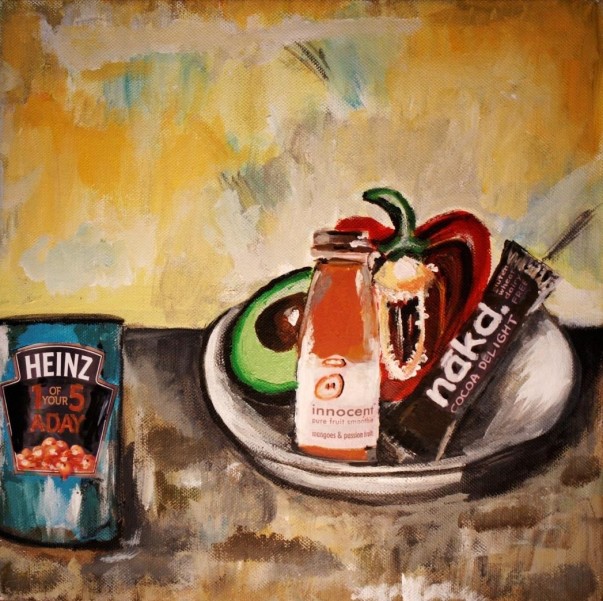“The clear message here is that the more fruit and vegetables you eat, the less likely you are to die at any age” (Oyebode et al. 2014).

Trying to get the population to eat more fruit and vegetables to reduce the burden of disease led to the launch of the 5-A-DAY campaign in 2003. However, the National Diet and Nutrition Survey in 2014 revealed that only 30% of adults actually manage to eat their 5-A-DAY. Even more concerning is the fact that the 5-A-DAY campaign has little scientific founding: data from the European Prospective Investigation into Cancer and Nutrition (EPIC) study found that eating 5-A-Day had little effect on decreasing cancer risk (Oyebode et al, 2013). Yet the 5-A-DAY logo, with green blocks descending into glowing yellow heavens of health promises us that if we eat our 5-ADAY, we will be saved from the horrors of ill-health.
I based my painting Still life with 5-A-Day on Cezanne’s Still life with Apples (Fig. 1), imagining what Cezanne might paint now if he were in a modern (albeit middle- class) kitchen. Apples have been replaced by snack bars, and oranges by smoothies: healthy-foods now have to be marketed and labelled, or a fashionable fad. To emphasize this marketing, I painted over printed labels of the brand names and stuck them onto my painting to make these items look as realistic as possible, in contrast to Cezanne’s expressive post-impressionist style. However, I chose a similar colour palate, and large brush strokes in the rest of the painting to make an obvious comparison to Cezanne’s work. This highlights a contrast to historical values of food: what do these new branded health-foods say about our attitudes to healthy eating?
And what does this mean for the future of the 5-A-DAY campaign?
Despite the fact that almost everyone knows about the 5-A-DAY campaign, the logo is seen less and less on a piece of fruit or a vegetable. Instead it resides on a few brands of dried fruit, juices, ready meals and even baked beans: these “healthy alternatives” are usually convenience foods and not healthy at all. It is hard to know why the logo is fading from view. However, its failure to improve consumers’ diets is likely to impact on the interest in marketers to adopt the logo. This is exacerbated by the lack of clarity and consistency with marketing products as 5-A-DAY. Not many of us know what quantity of fruit or vegetables count as 1 of your 5 a day: are we meant to eat 12 or 14 cherries?
What about if they’re organic cherries from M&S?!
Even the number ‘5’ behind the campaign is disputed. This number varies between 20 different countries: Denmark promotes 6-a-day, and Ireland just 4 and (Harcombe, 2012). However in the UK, researchers have called for the 5-A-DAY to be raised to 7A-DAY (Oyebode et al, 2013), just like the number in Cezanne’s still life. By only including 5 items in my version of the painting, I show how the number behind 5-ADAY is a result of marketing; it holds little value in improving our health.
This painting also links my next piece, based on the word real. The proliferation of health-food brands has meant that foods are now edited, packaged and marketing; they are nothing like the “real” foods that are found in Cezanne’s still-life paintings.
![Cezanne P. Still Life with Apples. 1890. The Hermitage, St. Petersberg. Source: WebMuseum, Paris [online].](https://superfoodsaint.files.wordpress.com/2015/11/cez.jpg?w=333&h=250)
References
Harcombe J. 2012. “Five a day: The truth. Diet, obesity, nutrition and big business.” So much, so wrong URL:http://www.zoeharcombe.com/2012/03/five–a–day–the–truth/. Accessed July 2015.
Oyebode,O, Gordon–Dseagu V, Walker A, S Mindell JS. 2014. “Fruit and vegetable consumption and all-cause, cancer and CVD mortality: analysis of Health Survey for England data.” J Epidemiol Community Health. doi:10.1136/jech-2013-203500.
